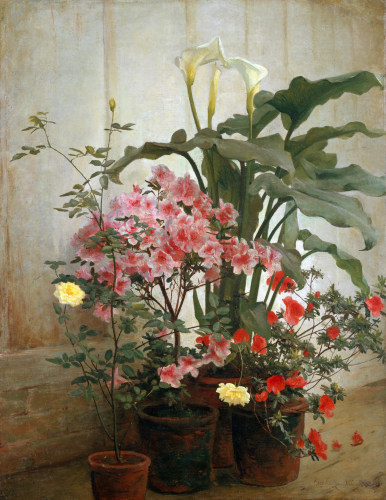George Cochran Lambdin

Side of a Greenhouse, ca. 1870–80
George Cochran Lambdin (1830 – 1896)
George Cochran Lambdin remains most known for his skill with floral paintings, especially roses from his own garden. However, during his lifetime, he was recognized for his sentimental genre subjects of which one of his most famous was The Dead Wife, completed in 1860. Its popularity, with the bereaved husband holding the hand of his dead wife, received special recognition when it was exhibited in the 1867 Exposition Universelle in Paris. Other genre subjects were from the American Civil War, resulting from his travels with the Union Army.
Lambdin also painted many portraits of Philadelphia women, usually accompanied by roses whose hues matched the complexion of the subject.
Lambdin was born in 1830 in Pittsburgh, the son of James Reid Lambdin, a successful portraitist from whom he received his early artistic training. In 1838, when he was eight, he moved with his family to the Germantown area of Philadelphia, and in 1848, he began exhibiting at the Pennsylvania Academy. At his family’s home when he was a young man, he began the cultivation of flowers that subsequently influenced his oil paintings and resulted in images which Louis Prang and Company of Boston converted into chromolithographs.
Germantown remained his primary home place, but Lambdin spent some years away, studying in Munich and Paris in 1855, Rome in 1870, and in the late 1860s living in New York City where he had space in the Tenth Street Studio Building.
From the 1850 through the 1880s, George Lambdin exhibited at the National Academy of Design, and in 1868, he was elected to membership.
Plagued by ill health, he quit painting in 1887, and he died in 1896.
Sources:
Mathew Baigell, Dictionary of American Art
David Dearinger, Paintings and Sculpture in the Collection of the National Academy of Design, 1826-1925.
Groce and Wallace, Dictionary of Artists in America
Biography from the Archives of AskART